How Breeding Programs Enhance Alpaca Color Diversity
You can boost your alpaca herd’s color diversity by using breeding programs that focus on the genetics behind coat color. By understanding key genes like ASIP and MC1R, you’ll make smarter pairing decisions that preserve genetic variety and improve fiber quality. This approach avoids narrowing the gene pool, helping keep your alpacas healthier and more resilient. Plus, aligning with consumer demand for natural, colorful fiber supports your herd’s market value. Keep exploring, and you’ll find how these strategies come together for better breeding success.
Key Takeaways
- Breeding programs use genetic testing of ASIP and MC1R genes to identify and select diverse color alleles in alpacas.
- Color genotyping informs pairing decisions that promote offspring with varied, naturally colored coats, reducing reliance on dyes.
- Maintaining color diversity through breeding enhances genetic health, disease resistance, and resilience in alpaca populations.
- Collaborative data sharing among breeders improves understanding of inheritance and supports preservation of diverse color genetics.
- Selective breeding aligns with market demand for eco-friendly, naturally colored fiber, increasing value and supporting sustainable farming.
Historical Context of Alpaca Domestication
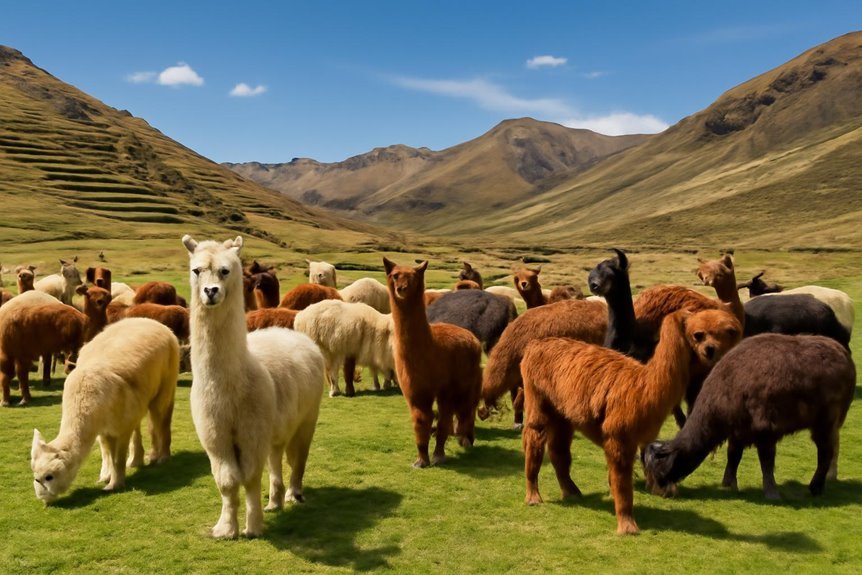
Although alpacas have been domesticated for over 5,000 years in the Peruvian Andes, their origins likely extend to northern Argentina and Chile as well. When you look into alpaca domestication, you’ll see it began as early humans shifted from hunting wild camelids to breeding alpacas specifically for their prized fiber quality. Over time, traditional husbandry practices shaped the alpaca population, focusing on traits like fiber softness and durability. However, as these methods declined, so did the genetic diversity within the herds, affecting breeding outcomes. White alpacas, highly valued for their versatile fiber, became a focal point in breeding programs, sometimes at the expense of broader genetic health. Understanding this history helps you appreciate the balance needed between maintaining fiber quality and preserving genetic diversity in alpaca breeding today.
Importance of Color Diversity in Alpaca Breeding
While white alpacas have long been favored for their versatile fiber, focusing too much on one color narrows the genetic pool, making herds more vulnerable to health problems. Embracing color diversity in alpaca breeding is essential for maintaining genetic health and ensuring a resilient population. Breeding programs that promote colored animals help restore genetic variation, which strengthens adaptability. You’ll find that:
- Color genotyping aids in making informed pairing decisions, boosting predictable, naturally colored offspring.
- Diverse colors align with eco-friendly consumer trends, reducing reliance on chemical dyes.
- Genetic variation reduces disease susceptibility and environmental stress impacts.
- Supporting small farmers through education enhances economic stability and breed sustainability.
Genetic Foundations of Coat Color in Alpacas
You’ll want to understand how key genes like ASIP and MC1R influence alpaca coat colors and how their different alleles are inherited. Knowing these patterns helps you predict offspring colors more accurately. This genetic insight is essential for making informed breeding decisions that enhance color diversity.
Key Color Genes
If you want to understand how alpacas get their diverse coat colors, you need to look closely at key genes like ASIP and MC1R. The ASIP gene influences pigment production, affecting black and brown shades, while the MC1R gene determines diluted or non-diluted colors. Different allele combinations, such as “a1,” “a2,” and “a3” in ASIP, interact to produce a wide range of alpaca coat color outcomes.
- The ASIP gene’s alleles balance eumelanin and pheomelanin, essential for black offspring.
- MC1R gene variants modify color intensity and dilution.
- Breeding strategies use color genotype knowledge to predict fiber colors.
- Maintaining diverse ASIP and MC1R allele combinations enhances genetic diversity and coat color variety.
Understanding these genes helps you tailor breeding programs effectively.
Inheritance Patterns
Because alpaca coat colors depend largely on genetics, understanding how the ASIP and MC1R genes pass from parents to offspring is key to predicting color outcomes. The ASIP gene has three alleles— a1, a2, and a3— where a1 increases the chance of a black coat, while a3 reduces it. MC1R also influences pigment, with the “E” allele promoting darker colors and the “e” allele causing dilution. Genotyping data from 181 alpacas reveals that specific allele combinations strongly affect coat color expression. When selecting breeding pairs, avoiding MC1R dilution mutations boosts the likelihood of true black offspring. By grasping these inheritance patterns, you can strategically pair alpacas to enhance color diversity and improve your breeding program’s effectiveness in producing desired coat colors.
Role of ASIP and MC1R Genes in Color Variation
You’ll find that the ASIP and MC1R genes play key roles in determining alpaca coat colors by influencing pigment production and color dilution. ASIP controls the balance between eumelanin and pheomelanin, while MC1R’s variations can change how those pigments express. Understanding how these genes interact helps you predict and select for specific color traits in your breeding program.
Genetic Influence on Pigmentation
While breeding alpacas for specific coat colors, you’ll find that the ASIP and MC1R genes play essential roles in determining pigmentation. The ASIP gene directly affects coat color, especially influencing the presence of black animals. Different alleles, like “a1,” “a2,” and “a3,” impact pigmentation and color outcomes, with “a1” linked to true black more frequently. Genotyping results reveal that many “aa” genotype alpacas without black fleeces carry “a3,” adding complexity to predictions. Meanwhile, MC1R influences color dilution, reducing black offspring likelihood when dilution mutations exist. Understanding these genes affecting pigmentation helps maintain genetic diversity and optimize breeding strategies. Key points include:
- ASIP gene alleles determine black versus brown shades
- MC1R mutations cause color dilution effects
- Genotyping results guide breeders on likely color outcomes
- Genetic diversity is enhanced by managing these gene variants
Interaction of ASIP, MC1R
Although the ASIP and MC1R genes each influence alpaca coat color independently, their interaction plays an essential role in creating the wide variety of hues you see. The ASIP gene controls pigment distribution, with the black ASIP allele—especially “a1”—linked to true black coats. Meanwhile, the MC1R gene regulates melanin production, affecting color intensity and dilution. When these genes interact, they determine specific phenotypes, such as the classic rose grey, which requires at least one black ASIP allele. Breeding outcomes become more predictable when you consider genotypes like “EE aa,” producing fawn or darker bases. Understanding this genetic interplay is significant for developing alpaca fiber with desired coat colors and shades, allowing you to enhance diversity and quality in your breeding programs.
Techniques for Color Genotyping in Alpacas
Anyone interested in alpaca breeding can use color genotyping techniques to reveal the genetic basis of fiber color. By analyzing the ASIP gene and its allele combinations, you can predict alpaca coat colors more accurately. The ASIP gene variants influence black pigment and base coat colors, resulting in diverse phenotypes. Color genotyping helps refine breeding strategies by identifying key allele combinations responsible for desired shades.
Color genotyping of the ASIP gene enables precise prediction of alpaca coat colors and improves breeding strategies.
Key techniques include:
- DNA sampling and PCR amplification targeting the ASIP gene
- Identifying alleles a1, a2, and a3 linked to black, silver grey, and other colors
- Interpreting genotypes like “aa” to predict black pigment expression
- Using allele combination data to map complex inheritance patterns in alpacas
These tools empower you to enhance color diversity in your breeding program.
Practical Applications of Genetic Data in Breeding
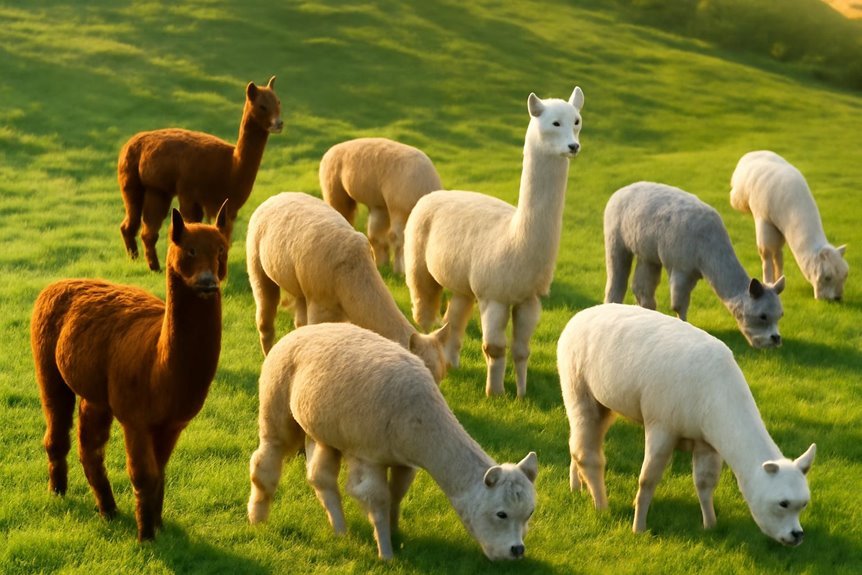
Building on the insights gained from color genotyping techniques, you can apply genetic data directly to improve your breeding decisions. By analyzing the ASIP gene, you’ll predict color outcomes more accurately—especially for black alpaca coats, as the “a1” ASIP allele often leads to true black offspring. This helps you select breeding pairs with greater precision, reducing unwanted white or off-color fibers. Utilizing genotyping data within breeding programs enhances your ability to produce targeted alpaca fiber colors while preserving genetic diversity. Collaborating with other breeders to share data deepens understanding of inheritance patterns, allowing you to maintain a healthy gene pool. Ultimately, applying these genetic insights streamlines your breeding strategy, boosts predictability in fiber colors, and supports sustainable alpaca color diversity on your farm.
Impact of Breeding Programs on Fiber Quality and Color
When you implement targeted breeding programs, you not only enhance fiber quality by focusing on traits like diameter, length, and uniformity but also improve color consistency through genetic insights. Selective mating guided by genetic research—especially involving the ASIP gene—enables you to influence alpaca fleece phenotypes for richer color diversity. These programs also maintain herd health by preserving genetic variation.
Key impacts include:
Key impacts include enhanced fiber quality, improved color consistency, and stronger, more diverse alpaca populations.
- Improved marketability of fiber through strict grading and sorting systems
- Enhanced color outcomes by applying knowledge of color genes in breeding decisions
- Increased resilience in alpaca populations by preventing inbreeding
- Expanded range of natural fiber colors meeting consumer demand
Collaboration and Education Among Alpaca Breeders
Although genetic research has advanced our understanding of alpaca coat color, it’s through collaboration and education among breeders that these insights truly translate into better breeding outcomes. When you engage in collaboration with other alpaca breeders, sharing genotyping data and experiences, you gain valuable knowledge about ASIP alleles like “a1” and “a2” that influence black and silver grey colors. This collective effort enhances breeding strategies focused on increasing color diversity. By participating in educational initiatives and reviewing phenotypic results together, you can make more informed decisions that improve your herd’s genetic potential. Programs like the color genotyping test introduced by Neogen Corporation have been pivotal, thanks to breeders from farms like Black Barn Alpacas and Cotton Creek Farms who contribute to this growing community of learning and progress.
Market Trends and Consumer Preferences for Alpaca Colors
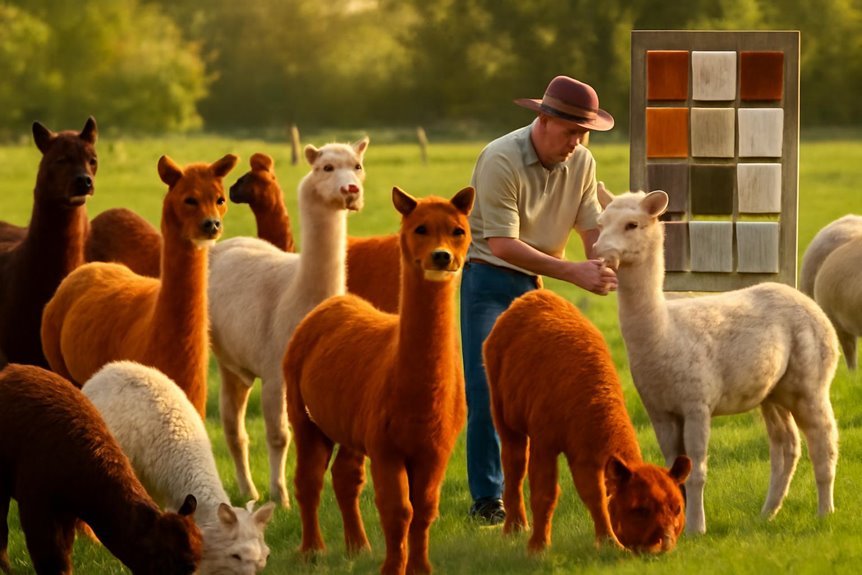
As interest in eco-friendly products grows, so does the demand for naturally colored alpaca fiber, shifting consumer preferences beyond the traditional focus on white fiber. You’ll notice market trends now favor diverse natural colors, reflecting a rise in ethical consumerism. While white fiber remains popular for dyeing, breeding programs are essential in preserving alpacas’ genetic diversity by promoting a wider palette of earth tones. Here’s what you should know:
- Growing demand for sustainable, naturally colored fiber enhances market value.
- Breeding programs help small farmers increase color variety and fiber quality.
- Consumer preferences now support ethical purchases favoring healthy alpaca populations.
- The decline in colored alpacas prompts breeders to innovate for long-term genetic diversity.
Understanding these factors helps you appreciate how breeding efforts align with evolving market trends.
Frequently Asked Questions
What Is the Color Genetics in Alpacas?
You’ll find alpaca color genetics involves complex color inheritance, where gene expression and genetic traits shape phenotype diversity. Using color mapping and selection pressure, breeding strategies create varied color variations by controlling and predicting these genetic influences.
What Is the Cultural Significance of the Alpaca?
You’ll find alpacas symbolize Andean heritage, linking spiritual beliefs and community roles. Their fiber’s significance shines in traditional textiles and cultural festivals, while their economic impact sustains families, preserving both culture and livelihoods through generations.
How Many Natural Colors Do Alpacas Come In?
You’ll find alpacas boasting 22 natural color patterns, a tapestry woven by color inheritance traits and genetic diversity importance. Color classification systems and breeding strategies highlight alpaca color varieties, shaped subtly by environment and color preference trends.
At What Age Should You Stop Breeding Alpacas?
You should stop breeding alpacas around 10 to 12 years, considering breeding age, health considerations, and genetic factors. Respect reproductive lifespan, practice good breeding ethics, manage your herd wisely, and plan retirement options to avoid financial implications.

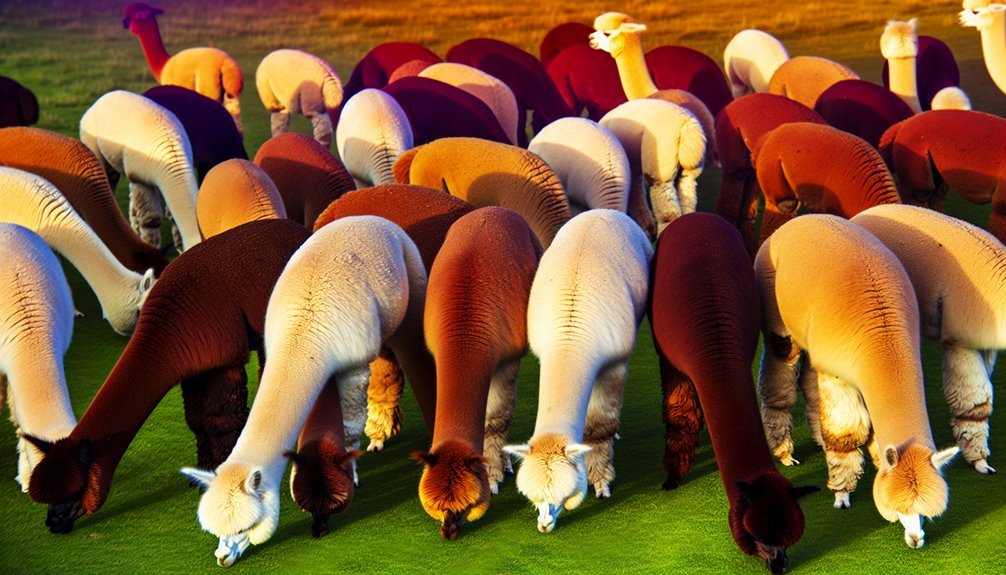




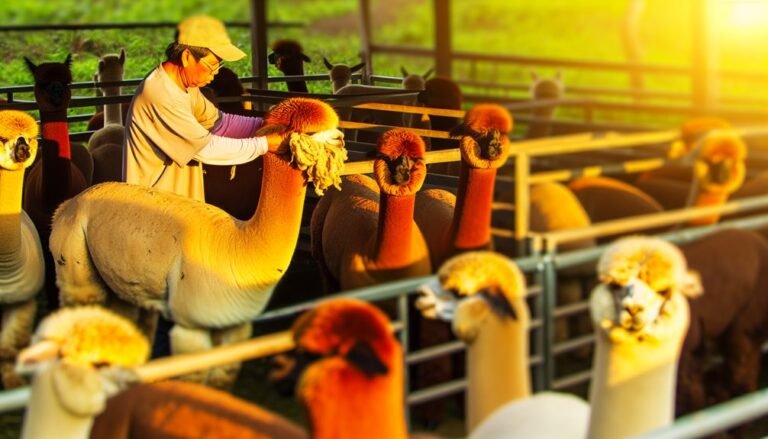
Our picks
Alpaca & Wool Felted Sole Inserts: Comfy Upgrade?
Best Alpaca Socks for Hiking: Ultimate Comfort and Durability on Trails
Best Alpaca Halter for Comfort and Control